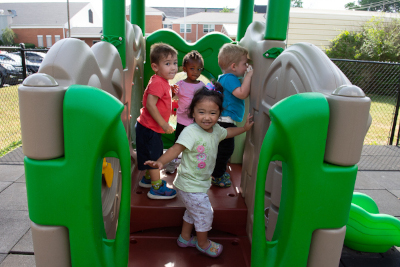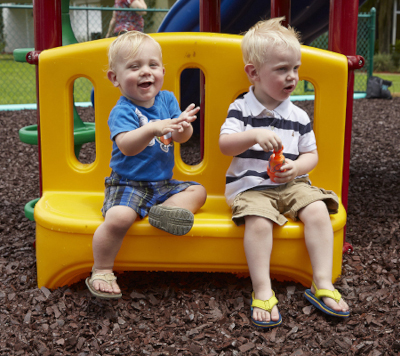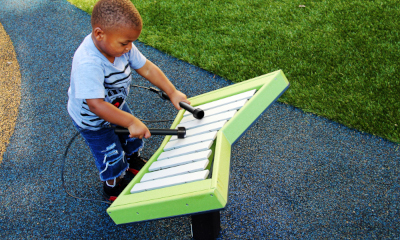Top 15 Playground Safety Questions
Posted by Jay-Paul Thibault on 13th Oct 2020
Planning for your playground is an exciting adventure. There are plenty of cool play systems on the market with imaginative themes. But one thing remains the same; safety. Before getting too set on anything for your new or existing playground, make sure you ask these 15 playground safety questions:
- Do you have enough space on your playground?
- What age groups will be using the playground?
- What are good types of safety surfacings?
- Could moving equipment like swingsets and merry-go-rounds be unsafe for children?
- What is the greatest risk of injury on the playground?
- Is there a way to test how safe my playground is?
- How much sun is too much sun on the playground?
- Will your playground have proper supervision?
- How can you keep kids safe even if they don’t follow the rules?
- How often do you need to update your playground?
- Are any playground materials like rubber mulch unsafe or potentially toxic?
- Where can I find the playground safety standards?
- Can I put seating in my playground for parents and guardians to supervise their children?
- What do I do if something breaks on my playground?
- How do I make sure my playground is safe from the very beginning?
1. Do you have enough space on your playground?
When planning a playground, having the right amount of space around your structures is important for keeping kids safe. To figure out how much space you need, start by figuring out if you are putting it in a residential or commercial space. For residential structures, maintaining 4-feet around the outside edge of the playground will be sufficient. However, if you are working on a commercial playground, there are a variety of rules to follow about how much space to leave and where. A good rule of thumb is 6 feet for most playground equipment. However, the following pieces have specialized rules:
- Swing sets
- Slides
- Pedestals
- Spinners
When adding those into a playground, be sure to with a Certified Playground Safety Inspector or the manufacturer for best installation recommendations.
 2. What age groups will be using the playground?
2. What age groups will be using the playground?
Playground equipment has 4 recognized age groups:
- 6-23 months
- 2 – 5 years
- 2 – 12 years
- 5 – 12 years
Of these, only the ones between 2 – 12 are included in the ASTM Standards. The CPSC includes the 6 – 23 month age group.
One of the most important reasons why playground equipment is divided into these age groups, is because they are developmentally different. That means children within these age groups can be appropriately challenged and be successful on the equipment. The 2 – 12 age group is really equipment designed to be safe for 2 – 5 with enough challenge that 2 – 12 year olds will enjoy it as well.
3. What are good types of safety surfacings?
While most of us grew up with sand, pea gravel, or grass under their playground equipment, there are testing guidelines for safety surfacing to reduce the chance of head trauma in the case of a fall. All that means is that safety surfacing is rated based on how high you can go before getting into serious head trauma range. This allows purchasers to make appropriate decisions for what type of safety surfacing goes under equipment.
As to which types of safety surfacings are the best, they are those with the IPEMA certification for ASTM F1292-17. This certification means that this material has been through rigorous testing to make sure that it is safe and meets the impact attenuation requirements against traumatic head injury.
 4. Could moving equipment like swingsets and merry-go-round be unsafe for children?
4. Could moving equipment like swingsets and merry-go-round be unsafe for children?
Swing sets, merry-go-rounds, spinners, and other similar gyrating equipment are some of the most developmentally important pieces of equipment. These pieces are what develop children’s vestibular sense, or more commonly known as balance. Balance is learned as children are put in motion either by themselves or by some other mechanism, like a merry-go-round being spun. Without these types of experiences, it can be more difficult for children to develop these senses. One of the most iconic reasons they need it is for riding a bike.
That all being said, they are moving making them less safe than stationary equipment. However, this comes back to maintaining equipment, installing equipment according to safety guidelines, and having proper supervision on the playground. If all of those points are followed, the equipment is safe for children to use.
5. What is the greatest risk of injury on the playground?
Falls. Think about it. When a child is climbing, they normally hurt themselves by falling. If they go down a slide too fast, they run a risk of falling as they dismount. Swings and spinning pieces of equipment are even more obvious in the ways kids can fall. However, with proper safety surfacing, proper use zones, and supervision, the number of falls can be greatly reduced.
6. Is there a way to test how safe my playground is?
Yes! There is a national list of CPSIs that are available to help test your playground. Not everyone on the list will conduct testing, however, that’s a great place to start. For example, Playground Outfitters employs CPSIs as part of their commitment to serving their customers with safe playground equipment.
7. How much sun is too much sun on the playground?
Sun is probably one of the most destructive forces on the playground. It can create a number of dangers on the playground. While more and more playgrounds are being made of plastic, plastic still gets hot in the sun. Due to safety concerns, installing a playground under a tree is typically not an option as it would require constant maintenance to keep the proper amount of distance between the playground and the tree branches. Adding a fabric shade is an excellent way to add shade to a playground while keeping equipment safe.
8. Will your playground have proper supervision?
 Some playgrounds are public and others are private. Most schools are considered semi private with children only playing on the equipment during the school day and they are typically very well monitored. However, public playgrounds like at a park are very difficult to ensure proper supervision. Placing a sign that states that adult supervision is recommended is one of the best ways to do so. Not every adult will read it, however, it sets the standard that you are asking kids to be supervised.
Some playgrounds are public and others are private. Most schools are considered semi private with children only playing on the equipment during the school day and they are typically very well monitored. However, public playgrounds like at a park are very difficult to ensure proper supervision. Placing a sign that states that adult supervision is recommended is one of the best ways to do so. Not every adult will read it, however, it sets the standard that you are asking kids to be supervised.
9. How can you keep kids safe even if they don’t follow the rules?
There will be children who play on playground equipment incorrectly and there is always a chance that someone can get hurt. One way to prevent this is to post rules at the front of your play area telling the age group and basic rules for using the equipment. Not everyone has grown up with the same rules so posting them rather than assuming people know the right way to use equipment is a good way to set a precedent for how you would like the equipment to be played on.
10. How often do you need to update your playground?
Playgrounds wear out at different rates based on the materials used and the number of children that play on them on a regular basis. As each manufacturer would recommend a different amount of time, a good rule of thumb is 5 – 10 years. The reason I use this number is because of warranties on parts of equipment. If you look closely at your warranties you’ll see metal components are often covered for a ridiculous amount of time that often exceeds 20 years. However, if you look more closely, some of the smaller components can be only a year. Plastics tend to be around 5 years. Now look at a modern playground: how much of the playground is plastic?
When I’m trying to make a recommendation on whether or not a playground should be updated I ask the following questions:
- Is any of the plastic starting to crack?
- Are any of the components broken?
- Has any of the metal begun to rust?
- Has anyone that uses the equipment begun to express concerns about it?
- Has a CPSI evaluated it and said it is unsafe?
Based on the number and severity of those yes’s, then you may want to consider replacing your playground.
11. Are any playground materials like rubber mulch unsafe or potentially toxic?
If playground materials are purchased through a playground manufacturer and it has an IPEMA certification, it should be safe. Rubber tires, especially if you purchase painted rubber mulch, have been washed before it’s painted. There should be no problem with children playing in it.
12. Where can I find the playground safety standards?
One of the best places to find them is through the NRPA. If you would like to become a CPSI to better maintain the safety of your playground, be sure to check out the certification process and test.
13. Can I put seating in my playground for parents and guardians to supervise their children?
This can often be a linguistically challenging answer. You cannot put any benches within the playground use zones, however, they can be in the playground if the proper amount of space has been prepared for it. Long as the benches are not interfering with playground usage, they are fine!
14. What do I do if something breaks on my playground?
First of all, don’t panic! Next you need to look at what it is. Most borders and swing parts can be easily replaced. If it is not an easily replaced part, look for the manufacturer on your playground equipment. Most of the time there is a sticker with a website or phone number to call. If you are able to get a hold of the manufacturer, they may or may not be able to get you a replacement part. Do not be surprised if the manufacturer says that they cannot.
After identifying this one broken part, we suggest looking for others. Oftentimes, when one part goes, it won’t be long until more will follow. If you find multiple areas that are beginning to break, it is probably time to buy a new playground.
15. How do I make sure my playground is safe from the very beginning?
The best way to ensure safety is to put it in from the start! If you are unsure how to make your playground safe, get the right kind of help. Some playground equipment companies have CPSI certified people on staff to help guide you, like we do! If you are feeling uncomfortable with trying to make a playground safe, you can always hire a CPSI to check your work or hire an installation company that has CPSIs on staff. There are lots of ways to make your playground safe!
At Playground Outfitters, playground safety is one of our top priorities! That is why we sell IPEMA certified surfacing and equipment. Call us today at (888) 342-8228 for help on your next playground project!


